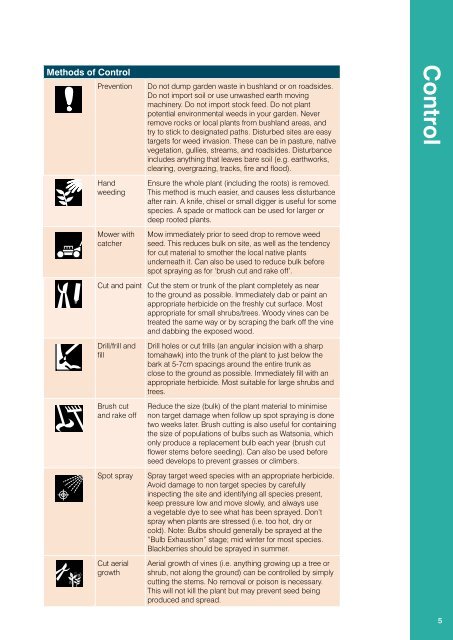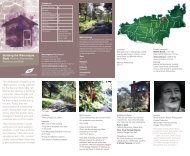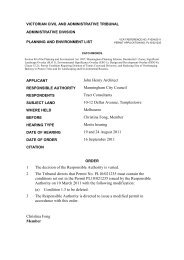Weeds Identification (PDF, 13MB, new window) - Manningham City ...
Weeds Identification (PDF, 13MB, new window) - Manningham City ...
Weeds Identification (PDF, 13MB, new window) - Manningham City ...
You also want an ePaper? Increase the reach of your titles
YUMPU automatically turns print PDFs into web optimized ePapers that Google loves.
Methods of Control<br />
Prevention Do not dump garden waste in bushland or on roadsides.<br />
Do not import soil or use unwashed earth moving<br />
machinery. Do not import stock feed. Do not plant<br />
potential environmental weeds in your garden. Never<br />
remove rocks or local plants from bushland areas, and<br />
try to stick to designated paths. Disturbed sites are easy<br />
targets for weed invasion. These can be in pasture, native<br />
vegetation, gullies, streams, and roadsides. Disturbance<br />
includes anything that leaves bare soil (e.g. earthworks,<br />
clearing, overgrazing, tracks, fire and flood).<br />
Hand<br />
weeding<br />
Mower with<br />
catcher<br />
Ensure the whole plant (including the roots) is removed.<br />
This method is much easier, and causes less disturbance<br />
after rain. A knife, chisel or small digger is useful for some<br />
species. A spade or mattock can be used for larger or<br />
deep rooted plants.<br />
Mow immediately prior to seed drop to remove weed<br />
seed. This reduces bulk on site, as well as the tendency<br />
for cut material to smother the local native plants<br />
underneath it. Can also be used to reduce bulk before<br />
spot spraying as for ‘brush cut and rake off’.<br />
Cut and paint Cut the stem or trunk of the plant completely as near<br />
to the ground as possible. Immediately dab or paint an<br />
appropriate herbicide on the freshly cut surface. Most<br />
appropriate for small shrubs/trees. Woody vines can be<br />
treated the same way or by scraping the bark off the vine<br />
and dabbing the exposed wood.<br />
Drill/frill and<br />
fill<br />
Brush cut<br />
and rake off<br />
Drill holes or cut frills (an angular incision with a sharp<br />
tomahawk) into the trunk of the plant to just below the<br />
bark at 5-7cm spacings around the entire trunk as<br />
close to the ground as possible. Immediately fill with an<br />
appropriate herbicide. Most suitable for large shrubs and<br />
trees.<br />
Reduce the size (bulk) of the plant material to minimise<br />
non target damage when follow up spot spraying is done<br />
two weeks later. Brush cutting is also useful for containing<br />
the size of populations of bulbs such as Watsonia, which<br />
only produce a replacement bulb each year (brush cut<br />
flower stems before seeding). Can also be used before<br />
seed develops to prevent grasses or climbers.<br />
Spot spray Spray target weed species with an appropriate herbicide.<br />
Avoid damage to non target species by carefully<br />
inspecting the site and identifying all species present,<br />
keep pressure low and move slowly, and always use<br />
a vegetable dye to see what has been sprayed. Don’t<br />
spray when plants are stressed (i.e. too hot, dry or<br />
cold). Note: Bulbs should generally be sprayed at the<br />
“Bulb Exhaustion” stage; mid winter for most species.<br />
Blackberries should be sprayed in summer.<br />
Cut aerial<br />
growth<br />
Aerial growth of vines (i.e. anything growing up a tree or<br />
shrub, not along the ground) can be controlled by simply<br />
cutting the stems. No removal or poison is necessary.<br />
This will not kill the plant but may prevent seed being<br />
produced and spread.<br />
Control<br />
5










